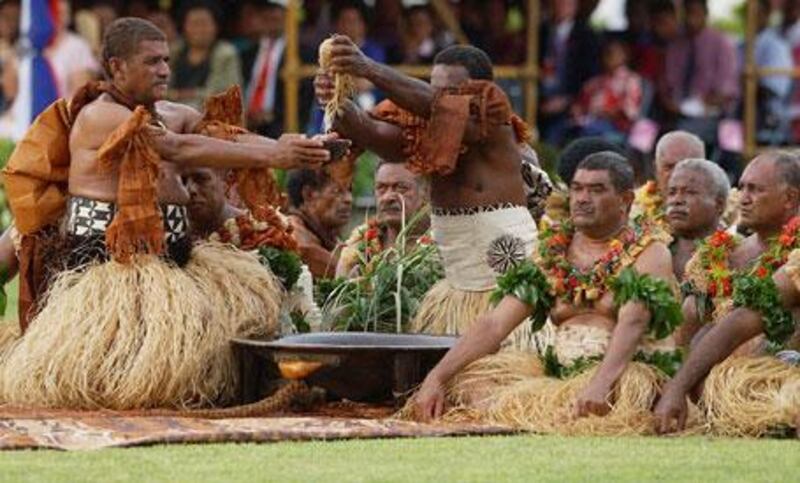At approximately 2am, I landed at Nadi airport in the small island nation of Fiji. As soon as I stepped off the plane I was hit by the balmy South Pacific air, a perfect contrast to New Zealand's chill. I was whisked away by a shuttle bus to the Nadi Bay Beach Resort, a sort of cross between a hotel and a hostel. Still standing but only half awake, I checked in around 3:30am and was led to a dorm room with eight beds - seven of which were occupied by snoozing travellers and I quickly joined their ranks.
I didn't have much planned for the following day other than I wanted to try to traditional Fijian food. I had lunch beneath an umbrella on the resort's terrace, sampling kokoda, a spicy salad of fish marinated in lemon juice and cooked in coconut cream. It was so good I had dinner there too - another seafood dish called lolo which was prepared by simmering fish in a thick coconut cream mixed with tomatoes and onions. All the hotel's Fijian staff were immediately friendly. They seemed to become even friendlier when they found out I was from the UAE. Many of them had never met anyone from the Gulf. Altogether I'd have to describe the Fijians I met as a good natured lot.
Having finished my dinner I sat at a table in front of two musicians playing covers of Lionel Richie and The Eagles. During the set break, one joined me. He was a rather plump man named Mala who was in his mid 40s and was missing a tooth. Soon we began talking about island life and then Fiji's political situation. I had read about the coup in 2006 that brought Frank Bainimarama to power, but I wasn't too sure how Fijians felt about this development. Mala, for one, seemed optimistic about Fiji's future but discontent about it's current situation.
In fact, I sensed anger when Mala explained that he was the father of seven and only earned about US$1.50 (Dh5.50) per hour at the resort. He was mainly upset with the Australian and New Zealand officials who since the coup have been discouraging their citizens from visiting Fiji because of security concerns. The consequences of any dip in visitors are immense in Fiji, Mala explained, because 50 per cent of the population work in jobs related to tourism.
According to Mala the previous prime minister, Laisenia Qarase, had been more focused on wealthy Fijians and foreign businesses and less on the poor. Mala said he didn't mind foreigners coming to make money, but he wished they would invest in local development instead of just turning a quick profit and sending it home. After our conversation, I retreated to my dorm as I had booked a "Beach Bum" tour package and needed to wake up early to visit Beachcomber, one of the smallest of Fiji's islands, which is about a 45-minute boat journey from Nadi's port.
Its view from a distance is that of a perfect oval rimmed in sand and with a jungly green centre. My boat docked at Beachcomber before the sun was too hot and I soon found a hammock and whiled away the hours reading a book. For a bit of exercise I kayaked to the nearest island, hiked around and returned. The dormitory I was staying at had approximately 50 bunk beds in one large hut and chickens roaming around outside, disturbing us with their ceaseless clucking. Most of the people there were gap-year travellers. Like me they had been attracted by Fiji's promise of beaches, diving and partying.
The following day I boarded a sail boat called Sea Spray as part of the tour package. We sailed through choppy waters to a place that everybody called "Cast Away Island" after the Tom Hanks film shot there. If I had to live for years in isolation I guess I would try to survive on the coconuts scattered on the beach and then probably die of malnutrition. Still, it was pretty. I can think of worse places to be stuck.
The Sea Spray's next destination was to another tiny island where we would visit a traditional Fijian village. The captain explained that he would select a "chief" from among us to represent our group. He chose one of the older people - an American who turned out to be quite comfortable in the role. Upon arrival we were greeted by village women in flowery dresses and men who had tied sheets of cloth around their waists that were quite similar to the wizar that Emiratis wear under their khanduras. However, wizars are white whereas in Fiji the cloths are brightly coloured. We walked through a souvenir market and were guided to a large, open room inside a vast hut. We were seated in lines and our chief was parked in front facing us during a ceremony to try kava, a traditional Fijian drink that has been highly important to Fijian culture for centuries and is made by soaking the roots of the kava plant. The brownish liquid is reputed to have a relaxing effect. There is a whole procedure to drinking kava properly. One of the members of the tribe approaches the chief holding a halved coconut shell. The chief claps once before grasping the coconut shell with both hands. He then gulps the drink down, after which he offers the shell back and claps twice. Then the rest of the group have a chance to try the drink. Most in our group didn't like kava, but I did. They said it tasted like muddy water but to me it was like a bitter tea served at room temperature which leaves a numbing sensation on the tip of the tongue.
Next week: Omar swims with sharks amid Fiji's coral reefs





